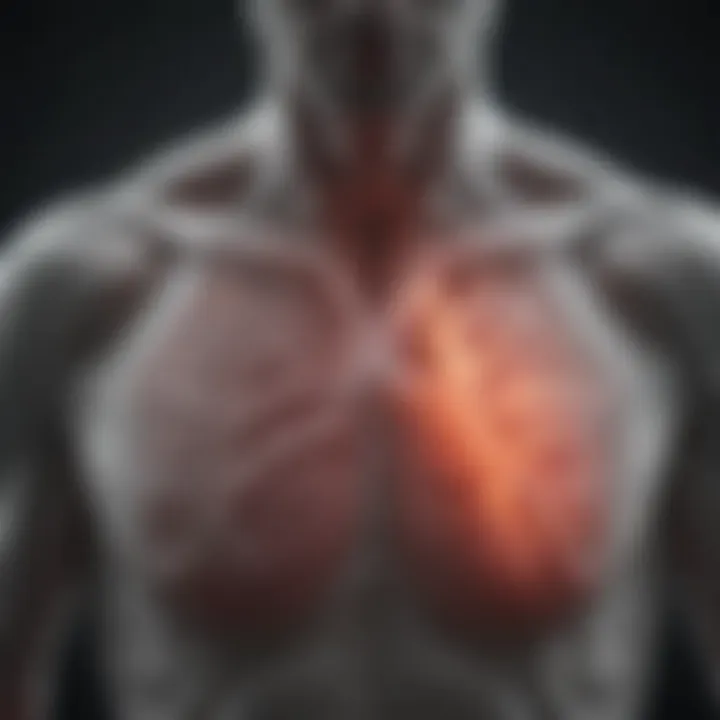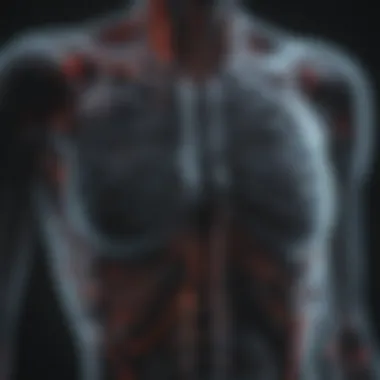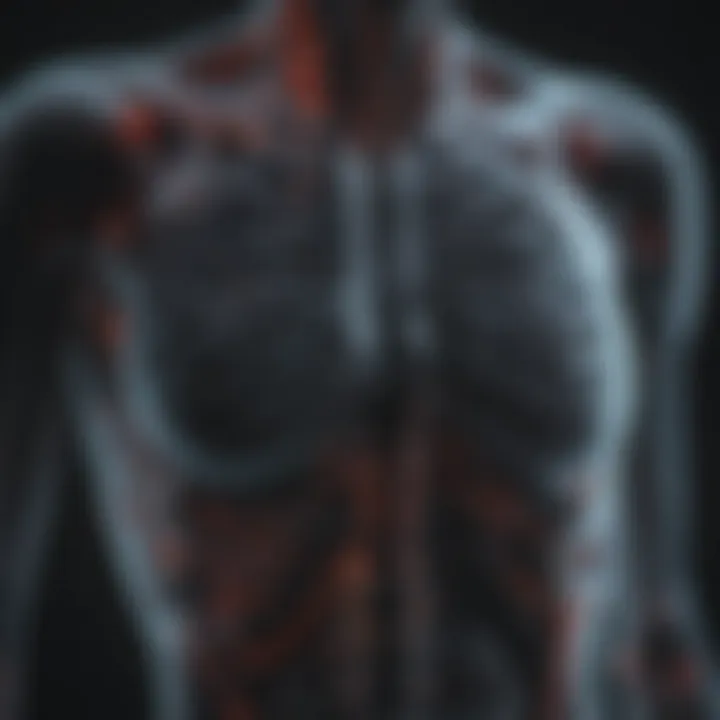Insights into TB Chest X-Ray: Diagnosis and Management


Intro
Chest X-rays have long been a fundamental tool in diagnosing and managing various lung diseases. In particular, tuberculosis (TB) stands out as one of the most significant infections where timely and accurate imaging can drastically change patient outcomes. As a framework for understanding this complex relationship, chest X-rays offer insights not only about the presence of TB but also about its progression and potential impact on treatment plans.
Background and Context
Overview of the Research Topic
The study of tuberculosis isn't just about the bacteria—it's about how health professionals unravel the clues that lead to an effective diagnosis. Chest X-rays play a pivotal role in this journey. By producing images of the lungs, they can reveal the initial signs of TB infection, allowing for a deeper understanding of what the disease looks like in its various stages. The ability to visualize the lungs means that doctors can act swiftly in a battle against an ailment that has affected millions worldwide.
Historical Significance
Historically, the emergence of chest X-ray technology marked a turning point in medicine. Before this innovation, diagnosing TB relied heavily on physical examinations and patient history. The advent of radiographic imaging brought about a sharper lens through which clinicians could view pulmonary health. The earliest X-rays, dating back to the late 19th century, transformed diagnostic capabilities, allowing for a more methodical approach to tackling the TB epidemic sweeping through communities.
Key Findings and Discussion
Major Results of the Study
Research indicates that the utilization of chest X-rays in TB diagnosis remains essential. They are not just supplementary tools but central to establishing a treatment plan. In studies, a significant percentage of patients diagnosed with TB had relevant findings on their X-ray images, underscoring the importance of radiographic evaluation in clinical settings.
Detailed Analysis of Findings
The interpretation of chest X-rays for TB often reveals:
- Infiltrates: These appear as hazy regions on the X-ray and indicate an accumulation of fluid or other materials within the lungs.
- Cavitary lesions: Characteristic of advanced TB, these hollow spaces show that significant lung tissue has been compromised.
- Lymphadenopathy: Enlarged lymph nodes visible on X-rays may point to a TB infection beyond the lungs, emphasizing the systemic nature of this disease.
Understanding these critical features assists in distinguishing TB from other lung diseases, a process that can be nuanced and complex.
The significance of chest X-rays cannot be overstated; they allow for a glimpse into the lung's „inner workings,” packing crucial data needed for informed treatment decisions.
Furthermore, while chest X-rays hold numerous advantages, there are limitations. The sensitivity of X-rays can diminish in certain cases, leading to false negatives. This emphasizes the value of complementary diagnostic methods such as sputum tests and CT scans. The ongoing advancements in imaging technology also warrant discussion. New methods continue to emerge, promising even greater accuracy and utility in diagnosing TB.
As we move forward, it's vital to grasp the multifaceted role that chest X-rays play. In the complex landscape of tuberculosis diagnosis and management, they serve as essential allies in the face of a persistent, yet conquerable, foe.
Prelude to Tuberculosis
In the realm of infectious diseases, tuberculosis (TB) stands out as a significant global health challenge. Understanding TB is essential for medical professionals and researchers to improve diagnostic techniques, treatment methodologies, and ultimately patient outcomes. The pulmonary form of TB is the most common, affecting the lungs and posing serious health risks if left untreated. The relevance of this topic in our discussion on chest X-rays cannot be overstated, as a foundational knowledge of TB allows for a more nuanced approach to imaging and diagnosis.
Diagnosing TB accurately is critical. If caught early, treatment can prevent disease progression and curb transmission. This is where chest X-rays come into play, serving as a vital diagnostic tool in the detection and evaluation of TB. They help in visualizing lung involvement and assessing the extent of disease which is paramount not just for confirming diagnosis but also for monitoring treatment efficacy.
In grasping the complexities surrounding TB, one must look into its etiology and pathophysiology. This provides the groundwork necessary for interpreting radiological signs that will be discussed later in this article. A distinct understanding of TB also necessitates awareness of epidemiological trends, highlighting which populations are at greater risk and how public health strategies are implemented.
As we forge ahead, each component of TB, including its epidemiology, mechanics, and radiological implications, will weave a rich tapestry of knowledge poised to empower students, researchers, educators, and healthcare professionals alike. With a keen eye on this disease, we can better navigate the often turbulent waters of diagnosis and treatment.
Understanding Tuberculosis
TB is caused by the bacteria Mycobacterium tuberculosis, which spreads through inhalation of airborne particles from an infected individual. Characteristically, it manifests primarily in the lungs but can also affect other organs such as the kidneys, spine, and even the brain. This multi-faceted nature of TB calls for a comprehensive understanding, particularly its symptoms—such as chronic cough, weight loss, night sweats, and fever—which may vary significantly across individuals.
Achieving a successful outcome hinges on early detection and intervention. The immune response to the bacteria plays another crucial role. Some individuals lay dormant with latent TB, maintaining no symptoms and hence, posing a lesser risk, while others progress upon attaining active TB. This dichotomy emphasizes the importance of timely screening and identification through methods like chest X-rays.
Epidemiology of TB


TB is not merely a medical issue; it's a public health concern that underscores economic, social, and cultural factors, which all intertwine to influence its spread. Certain areas of the world bear a heavier burden of TB, especially in regions like sub-Saharan Africa and Southeast Asia where health resources may be limited.
A few key factors influencing TB epidemiology include:
- Socioeconomic Status: Poor living conditions and inadequate healthcare access can create a breeding ground for TB outbreaks.
- HIV Co-infection: Individuals living with HIV are at a significantly greater risk of developing active TB due to compromised immune systems. This relationship complicates treatment as both conditions need to be effectively managed together.
- Immigration Patterns: Movement of populations from high-incidence TB areas impacts prevalence in receiving regions, thus signaling the need for continuous monitoring and public health strategies.
Understanding these epidemiological aspects enhances our grasp on not just the "how" but the "why" behind the continuing burden of TB globally. This context ties back into the use of chest X-rays as they can assist in identifying not just the disease but also aid in understanding potential outbreak hotspots.
The Importance of Chest X-Rays in TB Diagnosis
The chest X-ray is often the first line of defense when it comes to diagnosing tuberculosis (TB). Its significance lies not just in providing images, but in helping to form a clinical picture that combines history, symptoms, and imaging results. In TB management, the ability to visualize changes in lung parenchyma can be a distinguishing factor between different pulmonary diseases. Hence, chest X-rays serve as an indispensable tool for both initial screening and ongoing assessment of TB cases.
Overview of Radiological Techniques
The realm of radiology encompasses a range of techniques, each with its own merits. Chest X-rays specifically leverage the contrast between air-filled spaces and denser structures like bone or pathological lung tissue, offering clear images of the thoracic cavity. Techniques include:
- Digital Radiography: A modern advancement where images are captured electronically, allowing for enhanced processing and analysis.
- Fluoroscopy: Though less commonly used for TB, it provides real-time moving images.
- CT Scans: While not a substitute for the chest X-ray, these can complement findings when more detailed views are needed.
Not only do these techniques facilitate early detection, but they also enable physicians to gauge the extent of infection, evaluate treatment response, and monitor complications that might arise during the course of therapy.
Role of Imaging in TB Assessment
When a patient presents with symptoms suggestive of TB, such as prolonged cough, fever, or night sweats, the chest X-ray becomes a critical element in the assessment strategy. Imaging plays several roles:
- Identifying Radiological Signs: Chest X-rays can reveal classic signs of TB, like cavitary lesions or consolidations, which can signify active disease.
- Differentiating Severity: Such imaging can help determine whether the disease is localized or more extensive, impacting treatment decisions.
- Assessing Complications: It can also reveal other complications, such as pleural effusions or secondary infections, providing a more comprehensive view of the patient’s condition.
"The chest X-ray doesn't just show what's wrong; it helps narrate the story of the patient's illness."
Cumulatively, these aspects underline the chest X-ray's importance in guiding clinical decision-making and tailoring individual patient management strategies. The synergy of imaging with clinical evaluations creates pathways for timely interventions, often elevating patient outcomes in the long run.
Technical Aspects of TB Chest X-Ray Imaging
Understanding the technical aspects of TB chest X-ray imaging is crucial for accurate diagnosis and effective treatment decisions. There are multiple layers to the technology behind X-rays that are not just about capturing an image but also about interpretation and clinical application. Getting this right can enhance our response to tuberculosis management. The details include a grasp of the fundamental principles behind X-ray machinery and how images are acquired and processed.
X-Ray Technology Fundamentals
To grasp the essence of chest X-rays, it's imperative to start with the fundamental principles of X-ray technology itself. The heart of this technology lies in the interaction between X-rays and the body. X-rays are a form of electromagnetic radiation, similar to visible light, but with much shorter wavelengths, giving them the ability to penetrate softer tissues. When X-rays pass through the body, they get absorbed at varying degrees by different tissues. The denser the material, the more X-rays it absorbs, which is why bones appear white on an X-ray film, while softer tissues appear in shades of gray or may even be invisible.
The X-ray machine projects a controlled burst of radiation towards the thoracic region. The resulting image, known as a radiograph, represents a two-dimensional projection of the three-dimensional structures within the chest. A well-calibrated machine ensures that the images produced are of high quality, enabling the identification of abnormalities such as those seen in TB.
Additionally, advancements in digital X-ray technology have provided improved image clarity, reducing exposure times and radiation dosage for patients. This is a crucial benefit, particularly in an age where both efficiency and patient safety are paramount concerns in medical imaging.
Principles of Image Acquisition
Image acquisition is not just a matter of clicking a button; it involves a specific set of protocols and conditions to ensure optimal results. One of the key factors during image acquisition is positioning. Patients must be positioned correctly to capture the best angle of the lungs. The standard posteroanterior (PA) view is often utilized, where the patient stands facing the X-ray plate with their chest against it, ensuring the heart is not enlarged in the imagery.
Once positioned, the X-ray machine must be properly calibrated. Factors such as the kilovoltage peak (kVp) setting can influence the contrast of the resulting image. Higher kVp settings improve penetration, allowing visualization of structures like the mediastinum, which is beneficial in TB assessment, as the disease can affect adjacent lymph nodes and lung fields.
Furthermore, the automatic exposure control (AEC) systems help to adjust exposure times based on the patient’s size. This feature is especially useful in pediatric cases, where minimizing radiation exposure is critical.
"The accuracy of TB chest X-ray interpretation is closely related to the conditions under which the images are taken."
Finally, post-processing techniques also play a role. Imaging software can enhance clarity and assist radiologists in detecting subtle signs of tuberculosis. This means that the technological prowess doesn’t end after the image is captured.


Reading and Interpreting TB Chest X-Rays
Reading and interpreting TB chest X-rays involves a detailed understanding of the radiological techniques specific to tuberculosis. It's not just about looking at a picture; it requires skill, knowledge, and an analytical approach to decipher what lies beneath the surface. The importance of this topic in diagnosing and managing TB cannot be overstated. A clear interpretation enables clinicians to differentiate between active TB, latent TB, and other possible respiratory conditions. Proper interpretation can lead to timely identification and treatment, ultimately improving patient outcomes.
Common Radiological Signs of TB
When it comes to identifying tuberculosis through chest X-rays, certain signs are indicative of this disease.
- Cavitary Lesions: One of the classic signs. Cavities can appear in the upper lobes of the lungs, often indicating severe pulmonary involvement.
- Consolidation: This may manifest as an area of increased density on the X-ray, suggesting a region of lung affected by inflammation or infection.
- Pleural Effusion: Fluid accumulation in the pleural cavity around the lungs may also point towards tuberculosis.
Each of these signs tells a unique story about the underlying pathology of the patient’s lungs, allowing for more informed clinical decisions.
Differentiating TB from Other Conditions
To effectively treat TB, medical professionals must distinguish it from other pulmonary diseases. Conditions presenting with similar symptoms can include:
- Pneumonia: Although similar, pneumonia often displays patterns of lobar consolidation rather than cavitary lesions.
- Lung Cancer: Tumors may manifest as masses, but they typically lack the cavitary changes characteristic of TB.
- Interstitial Lung Disease: Here, changes in lung architecture may show a reticular pattern on films, differing from the consolidations typically seen in TB.
Recognizing these differences is vital for appropriate management and treatment pathways.
Pitfalls in Interpretation
Even seasoned practitioners can fall prey to interpretation pitfalls. Misreading the signs or not recognizing the nuances can lead to severe consequences, such as misdiagnosis or delayed treatment. Common pitfalls include:
- Overlooking Subtle Findings: Small nodules or minor opacities can be easily dismissed if not scrutinized closely.
- Experience Bias: Relying too much on previous cases rather than each individual patient's context can cloud judgment.
- Accessory Findings: Sometimes signs unrelated to TB may overshadow the actual presence of the disease itself.
"A careful eye paired with comprehensive knowledge can transform a dark picture into a clear diagnosis."
In essence, the ability to read and interpret TB chest X-rays accurately is crucial for effective patient management. Continual learning and review of past images can sharpen one’s interpretive skills, ultimately making a real difference in TB diagnosis and treatment.
Clinical Decision-Making and Treatment Implications
Navigating the landscape of tuberculosis (TB) management requires a meticulous approach, especially when it comes to clinical decision-making. Chest X-rays serve as an indispensable component of this journey; their role extends far beyond mere imaging. They inform treatment pathways and crucial management strategies pivotal for patient outcomes. The synergy between radiological findings and clinical history significantly enhances diagnostic accuracy, leading to more tailored therapeutic approaches.
When a physician encounters a chest X-ray suggestive of TB, it presents an opportunity to deploy a carefully structured management plan. At this juncture, understanding how to integrate imaging findings with clinical evaluations is imperative. This section explores the guidelines that aid in making informed decisions based on X-ray results and elaborates on how these decisions influence subsequent treatment plans.
Guidelines for Management Based on X-Ray Findings
Managing TB effectively hinges on a robust understanding of radiological findings and their implications. Here are several key guidelines:
- Assessing Severity: X-rays can reveal the extent of pulmonary involvement, such as cavitations or consolidations. This information helps determine the necessary urgency in starting treatment.
- Choosing the Right Treatment Regimen: Positive identification of TB on an X-ray often necessitates specific first-line medications like isoniazid, rifampicin, ethambutol, and pyrazinamide. If imaging reveals resistance patterns, adjustments must be made accordingly.
- Evaluating Complications: X-rays may uncover complications like pleural effusions, which might require additional intervention. Physicians can decide quickly whether to drain fluid or adjust treatment based on these findings.
- Informed Patient Discussions: Clearly communicating what X-ray findings indicate can help patients grasp their condition. This transparency fosters trust and accommodates their treatment preferences.
Monitoring Treatment Efficacy
Once treatment is underway, diligent monitoring is pivotal for assessing its effectiveness. Chest X-rays serve again as a critical tool during this phase. Their role in evaluating improvement or deterioration in lung condition cannot be overstated. Here’s how to approach monitoring efficacy:
- Regular Imaging: Follow-up X-rays at prescribed intervals allow providers to evaluate the response to treatment. Typically, a follow-up is scheduled within two to three months post-initiation of therapy to ascertain the extent of resolution.
- Identifying Treatment Failures: If X-ray findings do not show improvement, further investigation into adherence to therapy should be initiated. Additionally, resistance testing may be conducted to rule out multi-drug resistant TB.
- Therapeutic Adjustment: Persistent radiological signs may warrant a review and modification of the treatment plan. This may involve switching to second-line drugs or considering more aggressive treatment options, depending on patient tolerance and clinical response.
Effective monitoring through X-ray imaging enhances the understanding of TB dynamics, guiding timely interventions that improve patient morbidity and mortality.
Limitations of Chest X-Ray in TB Diagnosis


When considering the role of chest X-rays in diagnosing tuberculosis (TB), it is crucial to recognize that while these imaging techniques provide significant insights, they are not infallible. Understanding the limitations associated with chest X-rays can help healthcare providers make more informed decisions about patient care. By identifying the shortcomings, clinicians can evaluate when supplementary diagnostic measures may be necessary.
Sensitivity and Specificity Issues
Chest X-rays are often the first line of imaging for TB diagnosis. However, one cannot overlook the sensitivity and specificity of this method, which significantly impacts diagnostic accuracy. Sensitivity refers to the test's ability to correctly identify patients with the disease, while specificity indicates its ability to identify those without the disease.
In general, chest X-rays have a moderate sensitivity for detecting active TB cases. For example, studies suggest that sensitivity can range from 70% to 90%, depending on factors such as the stage of the disease and the radiologist's experience. In the earlier stages, small pulmonary nodules or other subtle changes may not be easily detected, leading to false negatives. This can put patients at risk of delayed treatment, potentially allowing the disease to spread.
On the other hand, specificity can also pose issues. For many conditions, chest X-ray findings can present similarly to those of pulmonary TB. For instance, conditions like pneumonia or lung cancer can mimic TB symptoms, leading to false positives. Such challenges necessitate a cautious interpretation of X-ray results, as misdiagnosis could steer treatment plans in the wrong direction.
"To navigate the intricacies of TB diagnosis, understanding the limitations in sensitivity and specificity is paramount. It helps healthcare professionals discern when to utilize additional diagnostic tools."
Alternatives to X-Ray Technology
When chest X-rays are insufficient in providing a clear picture, alternative diagnostic modalities come into play. Some of these technologies can assist in effectively diagnosing TB, especially in challenging cases where clarity is lacking. Here are a couple of notable alternatives:
- Computed Tomography (CT) Scans
CT scans provide a more detailed look at the lungs compared to chest X-rays. They can reveal subtle lesions and abnormalities, potentially discovering TB in its earlier stages, which chest X-rays might miss. The cross-sectional images can help in better characterizing lesions, aiding in distinguishing TB from other respiratory pathologies. - Magnetic Resonance Imaging (MRI)
While MRI is less commonly used than CT for evaluating lung conditions due to limited accessibility, it can still be beneficial in specific scenarios, particularly for extrapulmonary TB. It can provide superior soft tissue contrast, allowing for the assessment of involvement in areas such as the spine or brain, where TB can manifest. - Molecular Tests
Techniques like polymerase chain reaction (PCR) amplify the DNA of Mycobacterium tuberculosis, offering rapid and specific results. These tests can be used in tandem with imaging techniques to confirm the presence of TB more definitively. - Ultrasound
Though not typically the go-to method, ultrasound can play a role in assessing pleural effusion or lymph node involvement related to TB. It's particularly useful in guiding procedures like thoracentesis.
Future Directions in TB Imaging
Advancements in imaging technology hold significant potential for the future of tuberculosis (TB) diagnosis and management. As TB remains a global health concern, it’s crucial to explore emerging techniques that can enhance the detection and delineation of this infectious disease. Keys to these advancements lie in improved diagnostic accuracy, better patient outcomes, and the ability to customize treatments based on more precise data. The next few sections delve into these innovative approaches, outlining their implications in the clinical arena.
Emerging Technologies in Diagnostics
In the quest to refine TB diagnostics, several emerging technologies have started making waves. One such advancement is digital radiography. This technique not only provides clearer images faster than traditional methods, but also allows for enhanced manipulation of the captured data. It can lead to improved visualization of subtle pulmonary changes often missed in standard chest X-rays.
Moreover, Three-Dimensional (3D) imaging is gaining traction. Unlike standard radiographs, this method offers a more comprehensive view of lung structures, facilitating the identification of abnormalities that may indicate TB, such as cavitary lesions. It is especially beneficial in challenging cases where conventional imaging might not paint the full picture.
Another noteworthy development is the integration of ultrasound imaging. While traditionally reserved for soft tissue imaging, tailored applications in chest ultrasound have shown promise in identifying pleural effusions related to TB, enhancing the clinician's toolkit.
"The advent of new imaging modalities presents exciting opportunities for more accurate and timely TB diagnosis."
Integrating AI in Radiology
Artificial Intelligence (AI) stands at the forefront of transforming radiological practices, including TB imaging. By employing machine learning algorithms, radiologists can achieve increased accuracy in interpreting chest X-rays. Algorithms trained on vast data sets recognize patterns that may escape even seasoned eyes, thereby reducing the rates of false positives and negatives.
AI-powered tools facilitate faster analysis and have the potential to triage patients, prioritizing cases that exhibit the most apparent signs of TB for immediate clinical attention. The application of AI extends beyond just detection; it can also support risk stratification by predicting disease progression based on imaging findings.
Moreover, the integration of AI enables continuous learning from new data. As more chest X-ray images are analyzed, these systems refine their capabilities, improving diagnostic performance over time. Considering the vast number of TB cases worldwide, the scalability of AI technologies can help healthcare systems tackle the burden more efficiently.
Epilogue
The conclusion stands as a pivotal segment in this discourse, shedding light on the extensive role that chest X-rays play within the broader context of tuberculosis diagnosis and management. It encapsulates the various dimensions explored throughout the article, reiterating the fundamental relationship between radiological imaging and clinical decision-making. The nuances of TB, alongside the technical aspects of chest X-ray interpretation, elucidate the invaluable contributions these imaging techniques bring to the table.
Summary of Key Points
In summation, the article highlighted the following key points:
- Critical Role of Chest X-Rays: Chest X-rays are essential tools for identifying pulmonary tuberculosis. They enable healthcare professionals to visualize the lungs and discern patterns indicative of TB.
- Interpreting Imaging Results: Understanding the common radiological signs of TB is crucial. This knowledge assists in differentiating TB from other respiratory conditions, aiding timely and accurate diagnoses.
- Limitations of X-Rays: While valuable, chest X-rays have their drawbacks. Sensitivity and specificity issues may lead to inconclusive results, which necessitates supplementary diagnostic methods.
- Future Perspectives: Emerging technologies and the integration of artificial intelligence hold promise for enhancing the accuracy of TB imaging, potentially improving patient outcomes.
Implications for Future Research
As we forge ahead, several avenues for future research present themselves, inviting exploration and innovation in the domain of TB imaging:
- Enhancing Diagnostic Accuracy: Investigation into advanced imaging techniques that could supplement X-ray findings is essential. This may include exploring the utility of MRI or CT scans in specific cases of complex TB.
- AI Integration: The implementation of machine learning algorithms to analyze chest X-rays may revolutionize how radiologists interpret images, potentially minimizing human error and expediting diagnoses.
- Broader Epidemiological Studies: Future studies should also examine the epidemiological trends related to TB incidence and how advancements in imaging correlate with improved detection and treatment strategies.
"The evolution of diagnostic imaging technology could create a paradigm shift in TB management strategies worldwide."
In essence, the conclusion serves not merely as a wrap-up, but as a springboard for future inquiry and advancements, stressing the ongoing need for innovation in the fight against tuberculosis.







